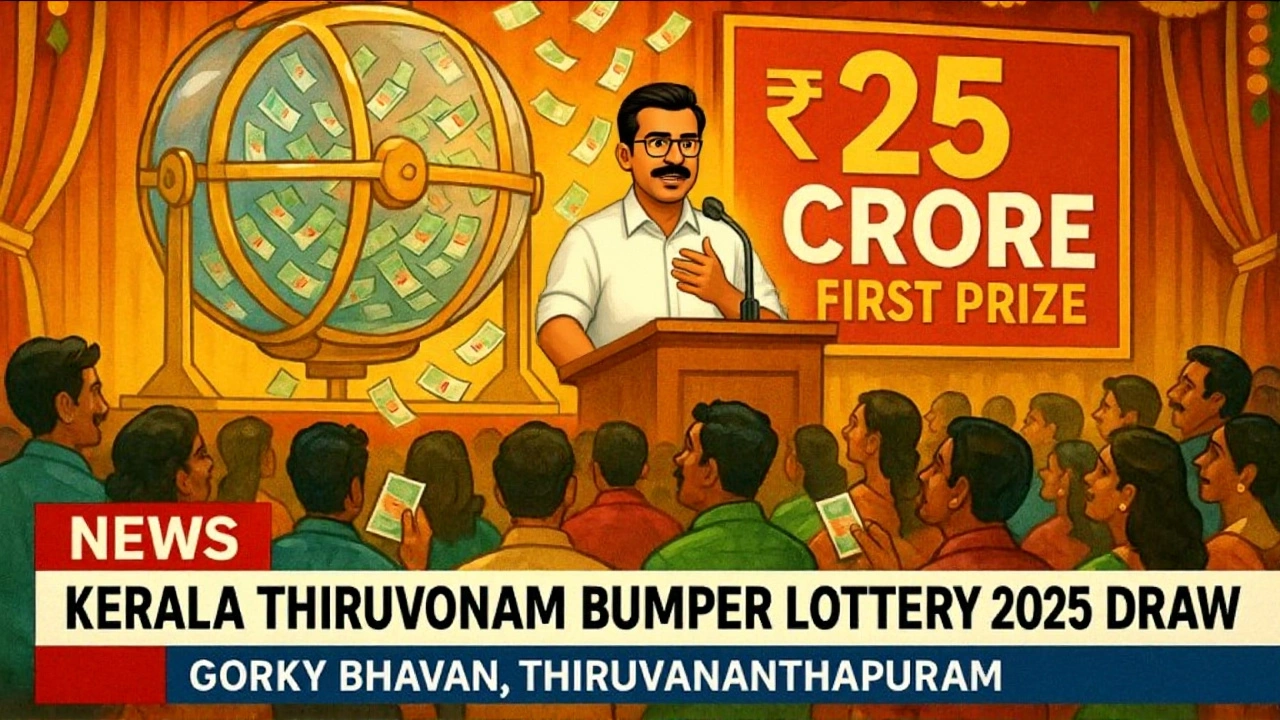
On Monday, November 24, 2025, at exactly 3:00 PM IST, a single ticket holder in Kerala walked away with ₹1 crore after the Bhagyathara BT-30 lottery draw took place at Gorky Bhavan near Bakery Junction in Thiruvananthapuram. The result, confirmed by Free Press Journal and Kerala State Lotteries Department, sent ripples through the state’s small-town economy — where lottery tickets are more than a gamble; they’re a lifeline. The first prize, ₹1,00,00,000, wasn’t just a windfall — it was a transformation waiting to happen.
How the Draw Unfolded — And Why Timing Mattered
Live updates began at 2:55 PM, but the official draw didn’t start until 3:00 PM sharp. By 4:00 PM, preliminary results were circulating on social media, while the Directorate of Kerala Lotteries held off on publishing the full PDF until 4:30 PM — a delay that sparked confusion among winners and agents alike. Times Now News live-blogged the event, noting that over 12,000 ticket agents across Kerala were on standby, their phones ringing nonstop as people scrambled to check numbers. The venue, Gorky Bhavan, has hosted every Kerala lottery draw since 1967 — a concrete symbol of continuity in a state where government-run lotteries are among the few reliable sources of public revenue.
The Prize Structure: More Than Just the Top Prize
While the ₹1 crore first prize grabbed headlines, the real story lies in the architecture of payouts. The Bhagyathara BT-30 draw featured nine prize tiers — not just one winner, but hundreds of small victories. The consolation prize of ₹5,000 was awarded to one ticket per series. Then came the tiered digit-based prizes: 114 tickets won ₹100 each, 94 won ₹200, 76 won ₹500, and 25 won ₹1,000 — all based on matching the last four digits of the drawn number. Even the fourth prize, awarded 19 times at ₹5,000, meant nearly 20 families walked away with life-changing sums. Altogether, the prize pool exceeded ₹1.5 crore, with nearly 350 winners across categories.
Claiming the Prize: A 90-Day Window, Not a Free Pass
Winners aren’t handed cash on the spot. The Directorate of Kerala Lotteries mandates a strict procedure: winners must verify their numbers against the official Kerala Government Gazette and surrender the physical ticket within 90 days. No exceptions. No digital claims. No extensions. That’s a critical detail many overlook. In rural Kerala, where literacy rates are high but access to government portals is uneven, this rule creates real barriers. One agent in Kottayam told reporters, “I’ve seen people hold onto winning tickets for months — afraid to claim, afraid of taxes, afraid of being targeted.” The government doesn’t withhold taxes, but the fear of sudden wealth changing relationships is very real.
Who Runs the Show? The Hidden Machinery Behind the Draw
The Kerala State Lotteries Department operates under the state’s Finance Department and is one of India’s oldest and most transparent state-run lottery systems. Established in 1967 under the Kerala State Lotteries Act, it’s funded entirely by ticket sales — no tax money. In 2024 alone, the department generated over ₹1,800 crore in revenue, funding everything from school uniforms to rural health camps. The draw itself is conducted under video surveillance, with two independent auditors present, and the winning numbers are printed on official forms in the presence of a government official. It’s not just a game — it’s a public service.
What’s Next? BT-31 on December 1 — And the Bigger Picture
The next draw, Bhagyathara BT-31, is scheduled for Sunday, December 1, 2025, again at Gorky Bhavan. The pattern is clear: every Monday for Bhagyathara series, with occasional Sunday draws for special editions. But here’s what’s not said out loud — ticket sales spike before holidays, monsoons, and elections. In the run-up to Kerala’s 2026 state elections, lottery revenues are expected to rise by 15–20%. Why? Because when people feel uncertain, they buy hope — one ₹40 ticket at a time.
Why This Matters Beyond the Numbers
For many in Kerala, especially in villages where average monthly income hovers around ₹8,000, a ₹1 crore win isn’t just wealth — it’s freedom. It’s paying off a debt, sending a child to college, building a house. But it’s also a reminder of how deeply economic anxiety is woven into daily life. The lottery doesn’t solve poverty. But it does offer a moment of possibility. And in a state where public trust in institutions is often low, the lottery’s transparency — the live draws, the gazette verification, the audited accounts — makes it one of the few systems people still believe in.
Frequently Asked Questions
How do I check if my Kerala Lottery ticket won the Bhagyathara BT-30?
Winners must compare their ticket number with the official results published in the Kerala Government Gazette, available on the state’s official portal or at district collectorate offices. Online sites like keralalotteryresult.net may show preliminary results, but only the Gazette is legally binding. Tickets must be surrendered within 90 days of the draw date — November 24, 2025 — to claim any prize.
Can I claim the prize if I bought the ticket outside Kerala?
Yes — the Kerala State Lotteries Department allows claims from anywhere in India, as long as the ticket is original, unaltered, and purchased from an authorized agent. However, you must still submit the physical ticket and a valid ID to the Kerala Lottery office in Thiruvananthapuram or an authorized regional claim center. No digital submissions are accepted.
Are lottery winnings taxed in Kerala?
No state tax is applied in Kerala, but the Indian Income Tax Department levies a flat 30% tax on prizes over ₹10,000, plus a 4% cess. For the ₹1 crore prize, the winner will receive approximately ₹69.6 lakh after deductions. The Directorate does not withhold tax — winners must declare and pay it themselves during income tax filing.
Why does the Kerala lottery always draw at Gorky Bhavan?
Gorky Bhavan has been the official draw venue since 1967, chosen for its central location in Thiruvananthapuram and its secure, government-controlled infrastructure. The building houses the lottery department’s administrative offices, and the draw room is equipped with tamper-proof machines, CCTV, and independent auditors. Changing the location would require legislative approval — and there’s no political will to do so. It’s tradition, security, and symbolism all in one.
How often are the Bhagyathara series draws held, and what does BT-30 mean?
The Bhagyathara series runs weekly on Mondays, with each number (like BT-30) indicating the sequence in the current cycle. BT-30 was the 30th draw of the current series, following BT-29 on November 17, 2025. The next, BT-31, is on December 1. The series resets every 52 weeks, meaning BT-52 is followed by BT-1. This system helps track results, prevent fraud, and maintain public trust in the draw’s fairness.
What happens if I lose my winning ticket?
Unfortunately, the Directorate of Kerala Lotteries does not replace lost, stolen, or damaged tickets. The physical ticket is the only proof of ownership. Even if you have a photocopy or a photo, it’s not valid. That’s why agents in Kerala often advise buyers to sign their tickets immediately after purchase and store them in a safe place — preferably with a witness.

Write a comment